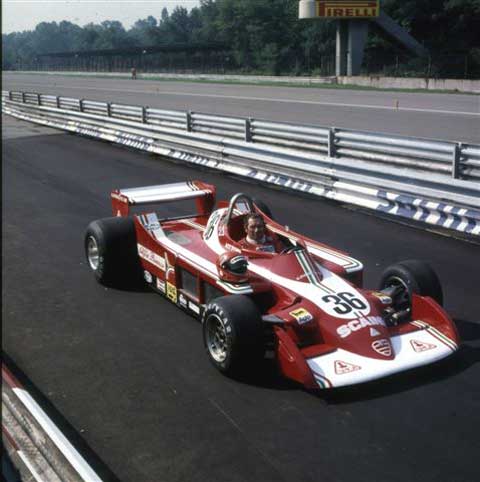 Vittorio Brambilla Monza in 1979 with the all-Italian Alfa Romeo 177. Archive photography by Automobilismo Storico Alfa Romeo Centro Documentazione (Arese, Milano).
Vittorio Brambilla Monza in 1979 with the all-Italian Alfa Romeo 177. Archive photography by Automobilismo Storico Alfa Romeo Centro Documentazione (Arese, Milano).
Story by Roberto Motta
Even though many people have not heard of it, the Alfa Romeo 177 is one of the most important cars in the long racing history of Alfa Romeo.
The 177 took part to only four races without a win or even a significant result, but it signaled the return of Alfa Romeo to the Grand Prix World Championships with a true all-Italian project which encompassed the car, chassis, engine and of course, the driver.
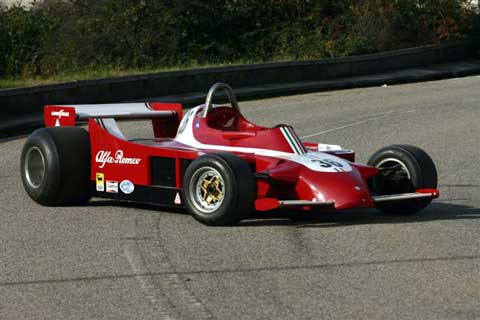 The one and only Alfa 177 as it appears today near the Alfa Museum. Photo by Roberto Motta.
The one and only Alfa 177 as it appears today near the Alfa Museum. Photo by Roberto Motta.
Alfa Romeo withdrew from Grand Prix racing in 1951 after the Milanese factory won the World Championship with Nino Farina in 1950 and with Juan Manuel Fangio in 1951 driving the Tipo 158/9 Alfettas.
The temptation to return to Formula One with a car built entirely by Alfa Romeo was very strong for the Milanese management. During the 1970 the Alfa Romeo returned to the Grand Prix circuits but only as engine provider to McLaren and March. In 1976 Alfa Romeo supplied engines to Brabham and in 1977, Ettore Massacesi, the general manager, gave the order to Autodelta to develop a new F1 car. Autodelta was the racing department of Alfa Romeo and its new workshop was situated at Settimo Milanese, a small town near Milano. The technical manager for the development of the new Alfa Romeo racing project was Carlo Chiti.
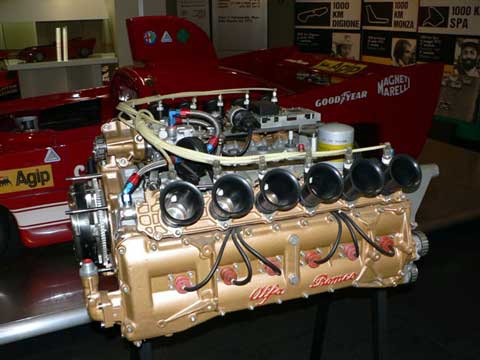 Carlo Chiti’s flat 12 three liter engine used in F1 produced 520 hp. Now, it only they could develop an Italian chassis for this engine and Italian driver Vittorio Brambilla. Photo by Roberto Motta.
Carlo Chiti’s flat 12 three liter engine used in F1 produced 520 hp. Now, it only they could develop an Italian chassis for this engine and Italian driver Vittorio Brambilla. Photo by Roberto Motta.
The new car was powered by the Chiti designed Alfa twelve-cylinder boxer engine used by Brabham in 1976. This engine, called Type 115-12, in its last version was able to produce 520 hp at 12000 rpm. The chassis used an aluminum monocoque with the engine mounted in a semi stressed configuration.
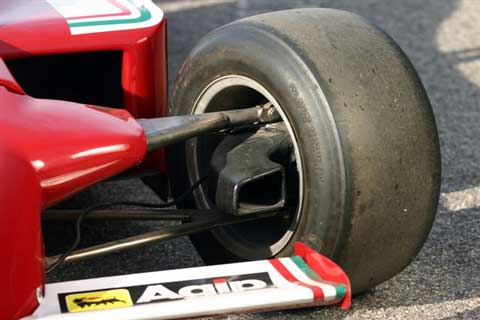 The 177 featured contemporary F1 design philosophy for the late 1970s, with progressive rate springs hidden by the body. Photo by Roberto Motta.
The 177 featured contemporary F1 design philosophy for the late 1970s, with progressive rate springs hidden by the body. Photo by Roberto Motta.
The front suspension was by unequal length wishbones, and a balance arm connected to vertical groups of shock-absorber was combined with progressive coil springs inside the body. The rear suspension also used upper and lower wishbones, with a set up very similar to the front. Adjustable anti-roll bars were used front and rear.
The car used four ventilated disc brakes, with Lockheed double-piston brake calipers and Ferodo pads. The front discs were mounted at the wheels and the rear mounted inboard near the differential.
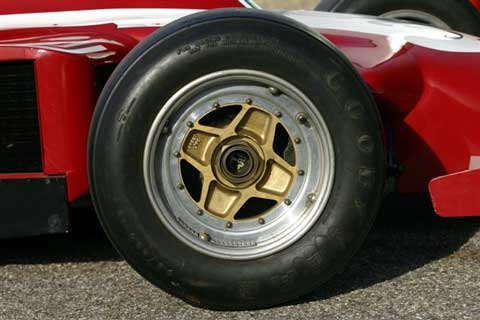 Front wheels by Speed-line were attractive and light. Photo by Roberto Motta.
Front wheels by Speed-line were attractive and light. Photo by Roberto Motta.
The wheels of the AR 177 were Speed-line in magnesium and the front measured 10†x 13″ and the rears were 17†x13″. The front tire measured 9.25/23/13″ and the rear 15.0/28.0/x13″.
Weight was just at 600 kg (1322.77 lbs.), the chassis had a wheelbase of 2740 mm (107.87 in), front wide track of 1660 mm (65.35 in) and rear track of 1610 mm (63.38 in). Two fuel tanks were mounted in a lateral position, and held 200 liters.
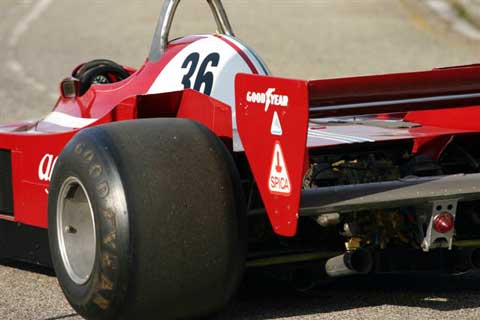 The 177 was not a ground effects car, and therein lay the problem. Photo by Roberto Motta.
The 177 was not a ground effects car, and therein lay the problem. Photo by Roberto Motta.
When it was designed, the 177 was unquestionably an advanced single-seater. Unfortunately the only chassis built, serial number 177-001, was not ready until May 1978 and for a number of reasons was not able to make its debut until the 1979 season. As you might recall, in that same season, Colin Chapman introduced the Lotus ground effect Formula One, possibly the best Grand Prix cars ever designed. This completely changed the engineering of Formula One cars, and the Alfa Romeo 177 became virtually obsolete before its debut, explaining why the 177 did not make any significant impact.
 Cockpit looks almost ancient by today’s standards. Note the Alfa emblem without “Milano” and the victory wreath. Photo by Roberto Motta.
Cockpit looks almost ancient by today’s standards. Note the Alfa emblem without “Milano” and the victory wreath. Photo by Roberto Motta.
Despite being upstaged by the new Lotus, Alfa’s first entirely new in-house Grand Prix car since 1938 would serve to ensure the return of Alfa to Grand Prix racing. Development continued and the 177 had its debut on May 30 1978, when it began its test at Balocco, the Alfa Romeo’s test track, with Vittorio Brambilla at the wheel. In this first test the body was still unpainted and used the new Pirelli tires.
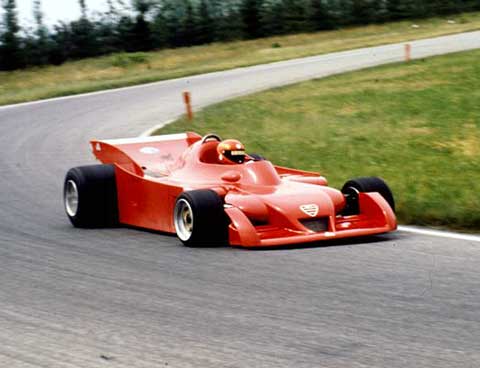 At Balocco in May of 1978, Brambilla tests the newly-painted Italian racing red 177. Archive photography by Automobilismo Storico Alfa Romeo Centro Documentazione (Arese, Milano).
At Balocco in May of 1978, Brambilla tests the newly-painted Italian racing red 177. Archive photography by Automobilismo Storico Alfa Romeo Centro Documentazione (Arese, Milano).
These were changed to Goodyear tires in August with further tests at Paul Ricard with Vittorio Brambilla and Niki Lauda. Hoping the car would be able to debut Monza on September 10, Autodelta found the results were negative and the debut was postponed. At Monza, Brambilla was driving for Surtees. During the race, Brambilla and his TS20 were involved in the multi-car accident which took the life of Ronnie Peterson, and Brambilla’s injuries meant that Alfa’s test driver was unable to race for almost a year. During the winter season, the 177 continued its development with Giorgio Francia, and later with the young Italian driver Bruno Giacomelli, both of whom had come up from the ranks of Formula 2 and Formula 3.
Finally, the car was entered in the Belgian GP at Zolder on 13 May 1979. The 177 with Giacomelli at the wheel made its best lap of 1’23â€15 seconds. Unfortunately, the day of the race during the 21st lap, the Shadow DN 9/B of Elio de Angelis arrived too fast in the corner and crashed into the rear of the AR 177 and the car was retired.
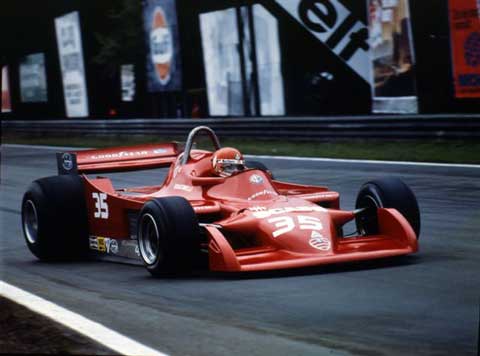 Bruno Giacomelli with the 177 at Zolder in 1979. He retired after being hit by the Shadow of de Angelis. Archive photography by Automobilismo Storico Alfa Romeo Centro Documentazione (Arese, Milano)
Bruno Giacomelli with the 177 at Zolder in 1979. He retired after being hit by the Shadow of de Angelis. Archive photography by Automobilismo Storico Alfa Romeo Centro Documentazione (Arese, Milano)
About six weeks later on July 1st 1979, the AR 177 was entered in the French GP with Giacomelli at the wheel. Here, the AR 177 had some engine trouble during practice and was 17th in practice. After a disappointing race the 177 finished in the same position as it had started.
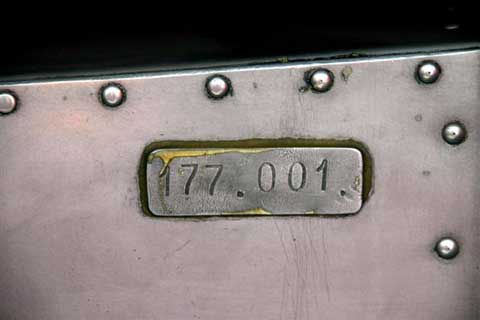 Photo by Roberto Motta.
Photo by Roberto Motta.
Some time later, the AR 177, with Brambilla at the wheel, had some private tests on the Hockenheim circuit with encouraging results; however, the 177 was not present at official practice.
On the 9th of September 1979, the 177 was entered in the Italian GP at Monza, and was driven by Brambilla. Now 42 years old, Brambilla was restarting his career on the same track where, an year before, he had been seriously hurt.
During the weekend, the Italian fans gave to the Alfa Romeo and the two drivers, Vittorio and Bruno an unforgettable reception. The AR 177 was 22nd in the practice and ended the race in 12th place. Autodelta had also entered the new 179/001 for Giacomelli. The AR179 was 18th in practice but did not finish the event.
A week later the AR 177 ran its last race at Imola in a non-championship Grand Prix dedicated to the memory of Dino Ferrari. For the first time in years, Enzo Ferrari was present during the practice.
During practice, Bruno and Vittorio took turns with the 177 but for the race the car was driven by Vittorio. The 177 started from the 6th place and finished ninth, again a lap behind the winner. In a strange twist of fate, after forty laps, the AR 177 was again hit by Elio De Angelis’s Shadow Ford.
This was the last run for the AR 177/001, and it ended its career at Imola.
But the 177 gave way to a more successful series of all-Alfa F1 cars which remained competitive until 1985.
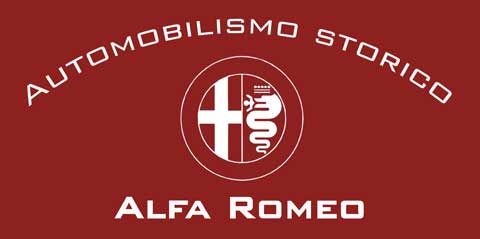 Our thanks to the Automobilismo Storico Alfa Romeo Centro Documentazione (Arese, Milano).
Our thanks to the Automobilismo Storico Alfa Romeo Centro Documentazione (Arese, Milano).
Good to see this kind of story about our favorite marque.
I am the editor of the Alfa Romeo Owners’ Club of Australia (Vic) quarterly magazine. The magazine 52 pages and full colour and is distrubuted free to our c1000 members. I was wondering if I could get permission to reprint this article and photos in our magazine?
COMPLIMENTI PER L ARTICOLO SONO ANTONIO NOIA ALFISTA APPASSIONATISSIMO DI AUTO E MECCANICA POTREI DARE UN CONTRIBUTO A VOI DELLA REDAZIONE CON NOTIZIE RIGUARDANTI IL MONDO AUTOMOBILISTICO.SAREBBE UN SOGNO CHE SI REALIZZA FARE DELLA PROPRIA PASSIONE IL PROPRIO LAVORO.DISTINTI SALUTI. NOIA ANTONIO TEL 3284314552